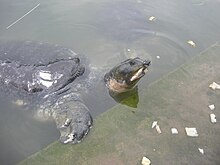| Black softshell turtle | |
|---|---|

| |
| Scientific classification | |
| Domain: | Eukaryota |
| Kingdom: | Animalia |
| Phylum: | Chordata |
| Class: | Reptilia |
| Order: | Testudines |
| Suborder: | Cryptodira |
| Family: | Trionychidae |
| Genus: | Nilssonia |
| Species: | N. nigricans
|
| Binomial name | |
| Nilssonia nigricans | |
| Synonyms[3][4] | |
The black softshell turtle or Bostami turtle (Nilssonia nigricans), previously placed in genus Aspideretes, is a species of freshwater turtle found in India (Assam and Tripura) and Bangladesh (Chittagong and Sylhet). It was long believed to consist of inbred individuals of the Indian softshell turtle (A. gangeticus or N. gangeticus) or the Indian peacock softshell turtle (A. hurum or N. hurum), but while it is a close relative of the latter, it is a distinct species.[5]
In the 1800s, it was believed these turtles were brought from Iran to Chittagong shrine pond by Hazrat Bayezid Bostami. His turtles he had brought to this pond were treated as sacred and respected by the public.[6] Previously declared extinct by the International Union for Conservation of Nature in 2002, these turtles were found still to exist in a temple's pond called the Hayagriva Madhava Temple located in Assam, and in Kalyan Sagar lake in Tripura Sundari Temple in Udaipur, Tripura, India.[7] Through conservation methods and protection of the species, some of these turtles can be found today throughout the wild, and scientists and environmental biologists are continuing to work hard to preserve this endangered species and their natural habitat. Their mitogenome represents relatedness to 19 other species of the Testudines. Nilssonia nigricans is the sister species of Nilssonia formosa.[8]
- ^ a b Praschag, P.; Ahmed, M.F.; Singh, S. (2021). "Nilssonia nigricans". IUCN Red List of Threatened Species. 2021: e.T2173A2778172. doi:10.2305/IUCN.UK.2021-1.RLTS.T2173A2778172.en. Retrieved 19 November 2021.
- ^ "Appendices | CITES". cites.org. Retrieved 2022-01-14.
- ^ Fritz Uwe; Peter Havaš (2007). "Checklist of Chelonians of the World" (PDF). Vertebrate Zoology. 57 (2): 311. doi:10.3897/vz.57.e30895. ISSN 1864-5755. S2CID 87809001.
- ^ "Nilssonia nigricans". The Reptile Database. www.reptile-database.org.
- ^ Praschag et al. (2007)
- ^ "'Bostami turtle' found in wild". The Daily Star. 13 July 2020.
- ^ Weston, Phoebe (11 June 2019). "Indian temple helps nurture 'extinct' turtle back to life". Independent.
- ^ Kundu, Shantanu; Kumar, Vikas; Tyagi, Kaomud; Chakraborty, Rajasree; Singha, Devkant; Rahaman, Iftikar; Pakrashi, Avas; Chandra, Kailash (2018-11-26). "Complete mitochondrial genome of Black Soft-shell Turtle (Nilssonia nigricans) and comparative analysis with other Trionychidae". Scientific Reports. 8 (1): 17378. Bibcode:2018NatSR...817378K. doi:10.1038/s41598-018-35822-5. ISSN 2045-2322. PMC 6255766. PMID 30478342.
